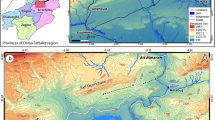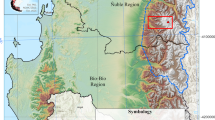Abstract
Both worldwide and in Mexico, multiple regions with thermal springs exist and have played an integral role in culture and daily life in these civilizations since pre-Hispanic up to modern times. Thermal springs have become places of high cultural importance, and most of the times have been used for balneology or as baths of local people. Unfortunately, in Mexico a lack of knowledge about the possible direct uses of geothermal energy for all these resources exists, and the relevance of their conservation, their role in the local sustainable development, and their historical trajectory as elements of local heritage and geo-heritage. The objective of this work was to classify the geoheritage in Puruándiro. In summary, this work presents two aspects of this classification: (1) classification of geosites in Puruándiro using educational, scientific, and cultural parameters according to the first geothermal exploration in the area and local opinion via a perception survey and (2) design and presentation of didactic and multidisciplinary material in Spanish (geo-map, geo-guide, and infographics) for use in situ in which the geosites and importance of their geoconservation are highlighted. The main results of this work denote highly scientific, educational, and cultural parameters of most of the thermal springs with a great potential for the direct use of geothermal energy in addition to highlighting these parameters as part of the local geoheritage and main axis in planning sustainable development of the region.




taken from Pinti et al. (2013)


modified from Pinti et al. 2013)





Similar content being viewed by others
Data Availability
Data are available by request to the corresponding author. Audiovisual material created for dissemination is also available by request and is covered by the Creative Commons “Attribution-No Derivs-NonCommercial” license; see http://creativecommons.org. It may be reproduced in its entirety as long as this publication is credited.
References
Arnórsson S (1983) Chemical equilibria in Icelandic geothermal systems—implications for chemical geothermometry investigations. Geothermics 12:119–128
Bouzekraoui H, Barakat A, El Youssi M, Touhami F, Mouaddine A, Hafid A, Zwolinski Z (2018) Mapping geosites as gateways to the geotourism management in central high-atlas (Morocco). Quaestiones Geographicae 1:87–102
Brilha J (2016) Inventory and quantitative assessment of geosites and geodiversity sites: a review. Geoheritage 8(2):119–134
Brocx M, Semeniuk V (2007) Geoheritage and geoconservation - history, definition, scope and scale. J R Soc West Aust 90(2):53–87
Bunduschuh J, Tomaszewska B (eds) (2018) Geothermal water management. Series sustainable water developments. Taylor and Francis Group, London UK, 1st edition, Vol 6
Canul DR (1986) Vulcanología de la Zona Termal de Puruándiro, Comisión Federal de Electricidad, Revista Mexicana de Geoenergía, Número 1. Volumen 1:255–264
Cano-Cruz M, Carrasco-Nunez G (2008) Evolucion de un crater de explosión (maar) riolitico: Hoya de Estrada, campo volcanico Valle de Santiago, Guanajuato. Mexico Revista Mexicana De Ciencias Geologicas 25(3):549–564
Cardellini C, Chiodini G, Frondini F (2003) Application of stochastic simulation to CO2 flux from soil: Mapping and quantification of gas release. J Geophys Res 108:2425
Castro MC, Ma L, Hall CM (2009) A primordial, solar He-Ne signature in crustal fluids of a stable continental region. Earth Planet Sci Lett 279(3–4):174–184
Cataldi, R, Hodgson SF, Lund JW (1999) Stories from Heated Earth. Our geothermal heritage. Geothermal Resources Council. 569 p
Cebria JM, Martin-Escorza C, Lopez-Ruiz J, Moran-Zenteno DJ, Martiny BM (2011a) Numerical recognition of alignments in monogenetic volcanic areas: examples from the Michoacan-Guanajuato Volcanic Field in Mexico and Calatrava in Spain. J Volcanol Geoth Res 201(1–4):73–82
Chandrasekharam D (1995) A prehistoric view of the thermal springs of India. In Barbier E (ed) International Geothermal Association. Proceedings of the World Geothermal Congress 1995 : Florence, Italy, 18-31, pp 385–387. https://www.worldcat.org/title/proceedings-of-the-world-geothermal-congress-1995-florence-italy-18-31-may-1995/oclc/33492772
Chiodini G, Cioni R, Guidi M, Raco B, Marini L (1998) Soil CO2 flux measurements in volcanic and geothermal areas. Appl Geochem 13:543–552
CARSED (Corporativo en Arquitectura, Servicios y Edificaciones) (2011) Atlas de Riesgos Naturales del Municipio de Puruándiro, Michoacán, Prevención de Riesgos en los Asentamientos Humanos, Obra No.: 116071PP063497, Expediente: MPM/DDU/01/2011, Michoacán, 87
Cataldi R (1999) The year zero of Geothermics. In: Cataldi R, Hodgson S, Lund J (eds) Stories from a heated earth. Our geothermal heritage. GRC & IGA, Sacramento, pp 137–144
de Lima JTM, de Souza Carvalho I (2020) Geological or Cultural Heritage? The ex situ scientific collections as a remnant of nature and culture. Geoheritage 12:3. https://doi.org/10.1007/s12371-020-00448-5
Eder W, Patzak M (2004) Geoparks-geological attractions: a tool por public education, recreation and sustainable economic development. September, Episodes 27(3):162–164
Gallego E (1998) “Protección y conservación de espacios naturales y del patrimonio geológico”, ZUBÍA, núm. Logroño 16:155–179
Grandgirard, V. (1997). Geomorphologie, protection de la nature et gestión du paysage. PhD Thesis Universite de Fribourg
GEOSITES (1996). A new conservation initiative, Editorial, Episodes, Journal of International Geoscience, Published by the International Union of Geological Sciences, News Reports vol. 19, no. 3, September, 87–88
Gomez-Tuena A, Orozco-Esquivel MT, Ferrari L (2005) Igneous petrogenesis of the Trans-Mexican volcanic belt. Geol Soc Am Spec Pap 422:129–181
Gómez-Vasconcelos MG, Garduño-Monroy VH, Macías JL, Layer PW, Benowitz JA (2015) The Sierra de Mil Cumbres, Michoacán, México: Transitional volcanism between the Sierra Madre Occidental and the Trans-Mexican volcanic belt. J Volcanol Geotherm Res 301:128–147
Gray M (2004) Geodiversity: Valuing and conserving abiotic nature. John Wiley and Sons, Chichester
Hach (2007) DR 2800 Spectrophotometer. Portable Laboratory Manual. Edition 2. Hach Company. Germany ww.hach.com
Hall CM, Castro MC, Lohmann KC, Sun T (2012) Testing the noble gas paleothermometer with a yearlong study of groundwater noble gases in an instrumented monitoring well. Water Resou Res 48(4). https://doi.org/10.1029/2011WR010951
Hasenaka T (1986) The cinder cones of Michoacán-Gunajuato, central Mexico: Berkeley. University of California, Tesis doctoral, CA, p 171
Hasenaka T (1994) Size, distribution, and magma output rate for shield volcanoes of the Michoacan-Guanajuato volcanic fi eld. Central Mexico: Journal of Volcanology and Geothermal Research 63:13–31
Hasenaka T, Carmichael I (1985) The cinder cones at Michoacan-Guanajuato, central Mexico: their age, volume, and distribiution, and magma discharge rate. J Volcanol Geotherm Res 25:105–124
Hasenaka T, Carmichael I (1987) The cinder cones of Michoacan- Guanajuato, Central Mexico: petrology and chemistry. J Petrol 28:241–269
Hernández Hernández MA, Pinti DL (2018) Preliminary results of noble gases in Cuitzeo Lake. Unpublished results from a CONACYT research grant. FSE-272697. Internal reports
Kelman I, Dodds R (2009) Developing a code of ethics for disaster tourism. IJMED 27:272–296
Kepinska B (2003) Geothermal resources and utilization in Poland and Europe. The United Nations University Report 2:1–17
Lund JW, Toth AN (2020) Direct utilization of geothermal energy 2020 worldwide review. Proceedings of the World Geothermal Congress 2020. https://www.geothermal-energy.org/pdf/IGAstandard/WGC/2020/01018.pdf
Migoń P, Pijet-Migoń E (2019) Natural disasters, geotourism, and geo-interpretation. Geoheritage 11(2):629–640
Osorio-Ocampo S, Macias JL, Pola A, Cardona-Melchor S, Sosa-Ceballos G, Garduño-Monroy VH, Layer WP, Garcia-Sanchez L, Perton M, Benowitz J (2018) The eruptive history of the Patzcuaro Lake area in the Michoacan Guanajuato Volcanic Field, central Mexico: Field mapping, C-14 and 40Ar/39Ar geochronology. J Volcanol Geoth Res. https://doi.org/10.1016/j.jvolgeores.2018.06.003
Ozima M, Podosek FA (2001) Noble gas geochemistry. Cambridge University Press, Cambridge. Second edition, 302 p. https://doi.org/10.1017/CBO9780511545986
Palacio Prieto, J.L (2013) Geositios, geomorfositios y geoparques: importancia situación actual y perspectivas en México, Investigaciones Geográficas, Boletín del Instituto de Geografía, UNAM. 24 – 37
Panizza M (2001) Geomorphosites: concepts, methods and examples of geomorphological survey, Chinese Science Bulletin, vol. 46, Supp. December
Pereira LS, da Silva Faria T (2020) Assessing the cultural values of the geodiversity in a Braziliancity: the historical center of João Pessoa (Paraíba, NE Brazil), Mata da Aldeia chart. Int J Geoheritage Parks 8:59–73
Pola A, Macias JL, Osorio-Ocampo S, Sosa-Ceballos G, Garduno-Monroy VH, Martinez-Martinez J (2015) El Estribo Volcanic Complex: evolution from a shield volcano to a cinder cone, Patzcuaro Lake, Michoacan, Mexico. J Volcanol Geoth Res 303:130–145
Pinti DL, Castro MC, Lopez-Hernandez A, Han G, Shouakar- Stash O, Hall CM et al (2017) (2017) Fluid circulation and reservoir conditions of the Los Humeros Geothermal Field (LHGF), Mexico, as revealed by a noble gas survey. J Volcanol Geotherm Res 333:104–115
Pinti DL, Castro MC, Shouakar-Sash O, Tremblay A, Garduño VH, Hall CM, Hélie J-F, Ghaleb B (2013) Evolution of the geotermal fluids at Los Azufres, Mexico, as traced by noble gas isotopes, δ18O, δD, δ13C and 87Sr/86Sr. J Volcanol Geotherm Res 249:1–11
Rodrigo-Alonso., López-Portillo., Lancaster-Jones. (2018). Los Villaseñor: desde Guayangareo, Michoacán, hasta la Independencia nacional. Universidad Nacional Autónoma de México-Instituto de Investigaciones Históricas, Históricas Digital, p. 353–388. http://www.historicas.unam.mx/publicaciones/publicadigital/libros/626/626_04_12_LosVillasenor.pdf
Reyes-Guzman N, Siebe C, Chevrel MO, Guilbaud MN, Salinas S, Layer P (2018) Geology and radiometric dating of quaternary monogenetic volcanism in the western Zacapu lacustrine basin (Michoacan, Mexico): implications for archeology and future hazard evaluations. Bull Volcanol 80(2):18
Reynard E, Panizza M (2007) Geomorphosites: definition,assessment and mapping, Géomorphologie: relief, processus, environnement, no. 3, 177–180
Reynard E, Fontana G, Kozlik L, Scapozza C (2007) A method for assessing "scientific" and "additional values" of geomorphosites. Geographica Helvetica Jg. 62. Heft 3:148–158
Reynard E, Perret A, Bussard J, Grangier L, Martin S (2016) Integrated approach for the inventory and management of geomorphological heritage at the regional scale. Geoheritage 1:43–60
Riede F (2016) Changes in mid- and far-field human landscape use following the Laacher See eruption (c. 13,000 BP). Quat Int 394:37–50. https://doi.org/10.1016/j.quaint.2014.07.008
Scarlett JP, Riede F (2019) The dark geocultural heritage of volcanoes: combining cultural and geoheritage perspectives for mutual benefit. Geoheritage 11:1705–1721. https://doi.org/10.1007/s12371-019-00381-2
Serrano E, González-Trueba JJ (2005) Assessment of geomorphosites in natural protected areas: the Picos de Europa National Park (Spain). Géomorphologie : relief, processus, environnement 3:197–208
SUMA, Secretaría de Urbanismo y Medio Ambiente. (2004) Estudio Técnico Justificativo del Parque Ecológico Agua Tibia-Jeroche, Municipio de Puruándiro, Dirección de Ordenamiento y Gestión Ambiental, Departamento de Áreas Naturales Protegidas, Morelia, Michoacán, México, p. 48
Semeniuk V (1997) The linkage between biodiversity and geodiversity. In: R Eberhard (ed), Pattern & processes: towards a Regional Approach to National Estate assessment of geodiversity. Technical Series No. 2, Australian Heritage Commission & Environment Forest Taskforce, Environment Australia, Canberra, p 51–58
UNESCO (1972) Convención para la protección del patrimonio mundial cultural y natural, Organización de las Naciones Unidas para la Educación, la Ciencia y la Cultura, París
Wang JY (1995) Historical aspects of geothermal energy in China. In Barbier E (ed) International Geothermal Association. Proceedings of the World Geothermal Congress 1995 : Florence, Italy, 18-31 May 1995. https://www.worldcat.org/title/proceedings-of-the-world-geothermal-congress-1995-florence-italy-18-31-may-1995/oclc/33492772. Florence, Italy, 389–394
Wen T, Castro MC, Hall CM, Pinti DL, Lohmann KC (2016) Constraining groundwater flow in the glacial drift and Saginaw aquifers in the Michigan Basin through helium concentrations and isotopic ratios. Geofluids 16:3–25
Wimbledon WAP, Ishchenko AA, Gerasimenko NP, Karis LO, Suominen V, Johansson CE and C. Freden en Barettino, D., W.A.P. Wimbledon and E. Gallego (eds.), (2000) “Proyecto Geosites – una iniciativa de la Unión Internacional de las Ciencias Geológicas; la ciencia respaldada por la geoconservación”, pp.73–100
Zavala BJA (2018) Puruándiro, 491 años de historia, Ediciones y Promociones Antorcha, Puruándiro, Michoacán, México, p 191
Acknowledgements
Authors thanks to CONACYT. Authors thanks to Keyla Rodríguez, Xochitl Flores Soto, Fabián Gutiérrez Bahena, Mariana Patricia Gómez Nicolas for their support during realization of didactic material and implemented workshops in situ.
Funding
Funding was provided by Project CONACYT 298107 “Geopatrimonio de Puruándiro.” Apropiación social del conocimiento de las humanidades, ciencias y tecnologías 2019, awarded to Instituto de Geofísica, UNAM. Additional funding was provided by Programa de Cátedras CONACYT and by Fondo Sectorial CONACYT-SENER-Sustentabilidad Energética, projects 272697 and 207032 of the Centro Mexicano de Innovación en Energía Geotérmica (CeMIE-Geo) project P-01 “Mapas de Gradiente Geotérmico y Flujo de Calor para la República Mexicana.”
Author information
Authors and Affiliations
Corresponding author
Ethics declarations
Conflict of Interest
All authors declare that they have no financial and personal relationship with other persons or organizations that may improperly influence (skew) their work.
Supplementary Information
Below is the link to the electronic supplementary material.
Rights and permissions
About this article
Cite this article
Jácome Paz, M.P., Gómez Piña, V.M., Prol Ledesma, R.M. et al. Geoheritage in Thermal Springs of Puruándiro, Michoacán, México. Geoheritage 13, 68 (2021). https://doi.org/10.1007/s12371-021-00584-6
Received:
Accepted:
Published:
DOI: https://doi.org/10.1007/s12371-021-00584-6




